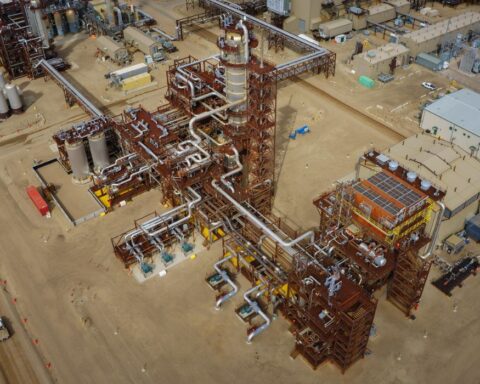Canada’s greenhouse gas (GHG) emissions continued to inch up in 2022 from mid-pandemic lows, but still showed a 25-year drop after excluding the COVID-19 crash, indicating that climate policies at least somewhat “bent the curve” on climate pollution, according to data released May 2 in the country’s latest National Inventory Report (NIR).
Total emissions of 708 million tonnes in 2022 exceeded the 2020 total of 672 megatonnes, but still put Canada’s climate pollution “significantly lower” than pre-pandemic levels in 2019, Environment and Climate Change Canada (ECCC) said in a release. Emissions were “the lowest they have been in 25 years, with the exception of the COVID–19 years (2020 and 2021), when the sudden, global economic slowdown caused emissions to drop sharply.”
The NIR shows Canada’s climate policies are starting to make a difference, Matt Dreis, senior analyst with the Pembina Institute’s oil and gas program, told The Energy Mix.
But “moving forward, the provinces need to be fully participating in the energy transition, especially for the sectors that haven’t reduced emissions as much as others,” he added.
The inventory shows that emissions in 2022 were 7.1% lower than in 2005, the base year used to measure national progress.
The hard work by Canadians to reduce emissions is paying off in new data showing that the country has “bent the curve,” Environment Minister Steven Guilbeault said in the ECCC release.
Emissions across the energy sector fell 7.7% compared to 2005 levels, even as they increased 73% in oil and gas extraction.
From 2021 to 2022, oil and gas sector emissions grew by one megatonne, “as companies continue to take action to reduce methane emissions and increase energy efficiency,” ECCC said. Yet “the oil and gas sector was once again the largest source of emissions in Canada in 2022,” accounting for around 31% of Canada’s total, CBC News reports.
The Alberta oil sands were the biggest contributor to that total, at 40%, followed by gas production and processing and conventional oil production, the NIR states. “The primary driver of emissions within the oil and gas sector is production growth.”
The tally of “unregulated pollution from oil and gas” had the sector accounting for more emissions in 2022 than buildings, heavy industry, and electricity combined, Climate Action Network Canada (CAN-Rac) said in a release.
“The electricity sector, small businesses, and heavy industry are working to lower their emissions. Families are doing their best to make climate-friendly choices,” said National Policy Manager Alex Cool-Fergus. “it’s only fair to hold the country’s highest-emitting companies accountable for reducing their pollution.”
CAN-Rac added that the long-awaited federal cap on oil and gas emissions, which is now going through the regulatory process, “would be one of the most effective measures to lower Canada’s emissions.”
The other “bigger picture,” Canadian Climate Institute Principal Economist Dave Sawyer said in a statement, was that emissions fell 5.9% between 2019 and 2022 while the economy grew 3.2%. The numbers amounted to “clear evidence that Canada continues to decouple emissions from economic growth.”
But that process “now needs to accelerate further — more than double — if Canada is to hit its 2030 target,” Sawyer added.
The 2022 results varied by sector and province. Emissions from heat and power production were down 54% since 2005 and 7% since 2021, due to reduced use of coal and refined petroleum products and an increase in low-emitting generation. Transportation emissions grew 7.8 megatonnes between 2021 and 2022, driven by the economic bounceback from the pandemic.
Alberta and Ontario accounted for 60% of the country’s climate pollution, but their emissions trajectories differed. Alberta’s total has continued to rise since 2005 because of the continued expansion of its oil and gas operations. Ontario initially reduced its emissions by completing its coal phaseout in 2014, but saw the total rise by about six megatonnes between 2021 and 2022, reflecting its increased reliance on gas-fired power generation. Alberta reduced its emissions by a megatonne over the same 12-month span.
Ontario “is driving up electricity sector emissions due to an increased reliance on natural gas and actively working to expand the natural gas network to new homes and communities,” Environmental Defence Canada Programs Director Keith Brooks said in a release. Currently, the Ontario government is working to overturn an Ontario Energy Board decision that would have protected homeowners from being saddled with the cost of new gas infrastructure.
Manitoba, the Yukon, and Nunavut each increased their emissions—all by less than one megatonne—while the other provinces all lowered theirs.
In 2018, the Intergovernmental Panel on Climate Change urged a 45% reduction in global greenhouse gas emissions by 2030 as the best path to avert the worst impacts of the climate emergency.
This story first appeared in The Energy Mix. Read the original article here.







